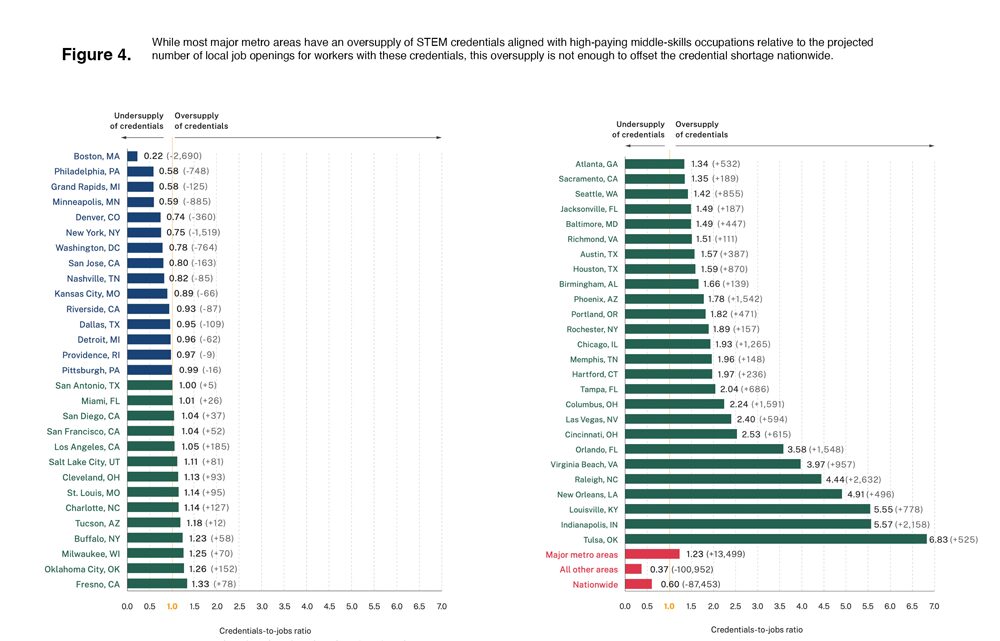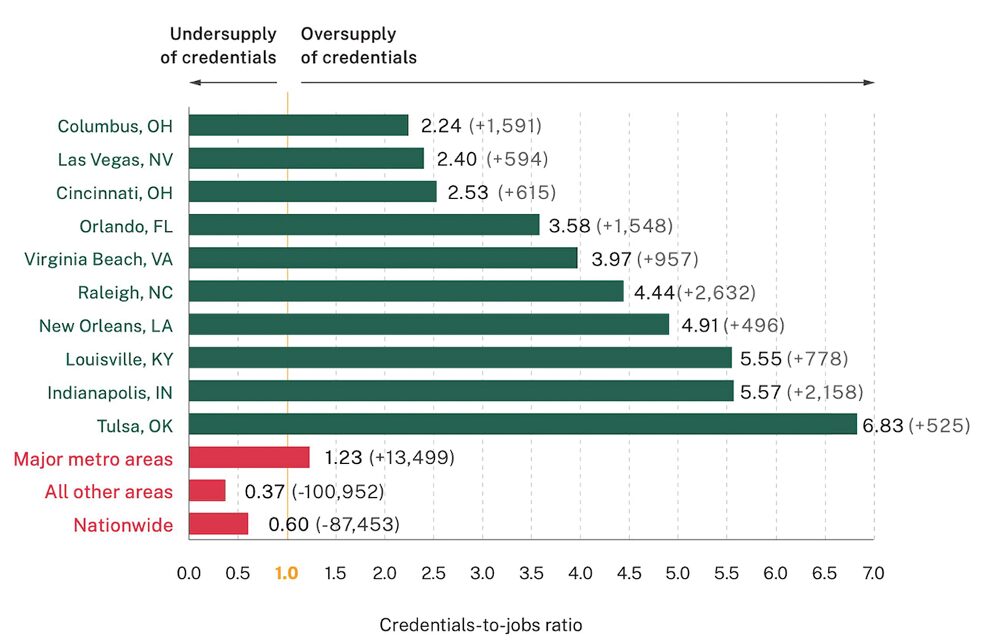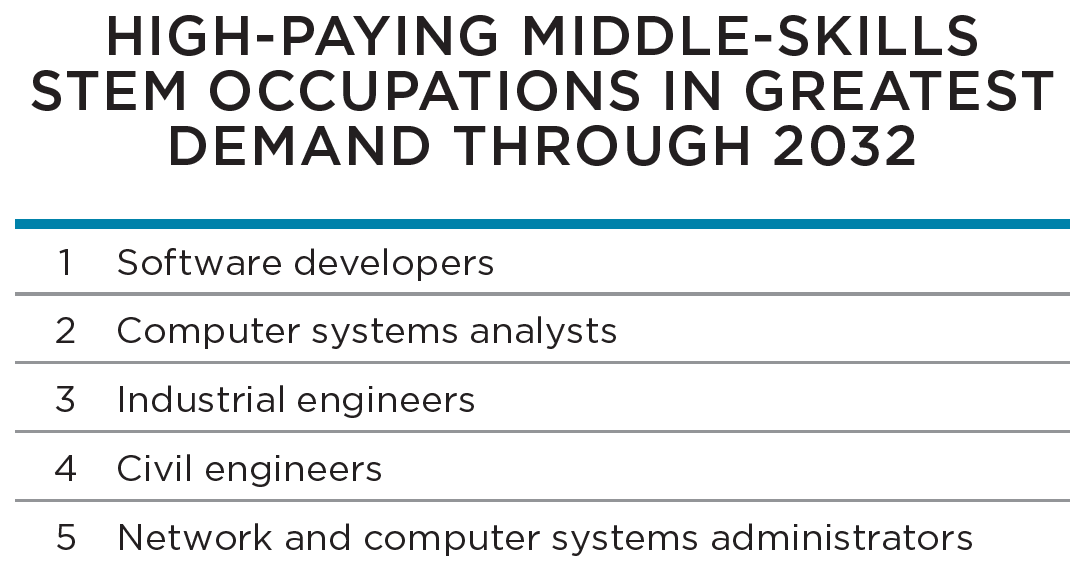Only health care is completely above the fray when it comes to the largest U.S. metro regions having enough middle-skills credentials to satisfy demand.
That’s one conclusion from “Missed Opportunities: Credential Shortages in Programs Aligned with High-Paying Middle-Skills Jobs in 55 U.S. Metro Areas,” a research report released in September 2024 by the Georgetown University Center on Education and the Workforce (CEW) with support from JPMorganChase.
What are high-paying middle-skills jobs? The CEW identified 107 occupations, including “such positions as firefighters, facilities managers, information security analysts, power plant operators and radiologic technicians.” The high pay watermark is defined as a job with annual earnings of more than $53,000 (in 2022 dollars) for early-career workers.
“Early-career middle-skills workers in these jobs not only outearn most young workers with a bachelor’s degree but also experience considerable earnings growth over time, with median annual earnings that rise to $80,000 by mid-career (ages 36–49),” says the report co-authored by Zachary Mabel, lead author and director of research at CEW, and CEW Director Jeff Strohl.
“High-paying middle-skills jobs are relatively rare — only 25% of early-career middle-skills workers earn more than most young workers with a bachelor’s degree,” said Mabel at the report’s release. “Nevertheless, the projected demand for high-paying middle-skills workers exceeds the current supply in certain sectors and localities. In many places experiencing shortages, middle-skills providers need to substantially expand their program capacity to prepare future workers for local jobs in high-paying fields.” That means pump up the volume of certificates and associate’s degrees.
The report groups the 107 occupations in five occupational groups: blue-collar; management; protective services; science, technology, engineering, and mathematics (STEM); and health care. Here’s a closer look at the blue-collar and STEM fields.
Blue-Collar Blues?
“The blue-collar sector will have the greatest nationwide shortage of workers prepared for high-paying middle-skills occupations, with 52 of the 55 largest U.S. metro areas experiencing shortages,” said Strohl. “If the current levels of annual credential production in programs aligned with these occupations don’t increase nationally, the credential supply will meet only 13% of the projected annual demand through 2032. As a result, annual credential production in aligned programs will fall short of annual demand by more than 360,000 credentials. We anticipate that Washington, D.C., Dallas and Boston will experience the greatest blue-collar shortages relative to projected labor-market demand.”
Then again, three of those 55 metro areas — Rochester, New York; Orlando, Florida; and San Jose, California — are expected to face a surplus of credentials aligned with high-paying blue-collar occupations. “Credential surpluses aren’t always a problem,” says the CEW report, “especially if local providers help address other areas’ education and training needs or graduates from oversupplied programs can use their knowledge and skills to find a high-paying local job in a different field.”

Graphs courtesy of Georgetown CEW

Graphs courtesy of Georgetown CEW
In Rochester that figures to be the case as the region responds to the massive investment from Micron in a semiconductor megafab located in Clay, New York, less than a two-hour drive east in the Syracuse metro area. The project is expected to generate as many as 50,000 total jobs. Micron intends to invest up to $100 billion over the next 20-plus years, with the first phase investment of $20 billion planned by the end of this decade. In addition to partnering with Syracuse University and Onondaga Community College in direct proximity to the fab, Micron’s $500 million “Community Investment Framework” includes enhancing its existing relationship with Rochester Institute of Technology and establishing the Future-Ready Workforce Innovation Consortium at Syracuse University with built-in collaboration across other four-year institutions in the state as well as community colleges, businesses and trade unions.
STEM Skills Ready
Contrary to the blue-collar situation, 40 of the 55 major metro areas are producing enough STEM credentials to align with projected needs, even as the overall national supply of such credentials is expected to meet only 60% of projected demand, falling short by 87,000.

Jeff Strohl, Director, Georgetown University Center on Education and the Workforce
But while some major STEM hubs such as Boston and the nation’s capital are expected to fall short of credentials aligned with high-paying STEM occupations, corporations looking to diversify geographically may find themselves looking at some of the areas the CEW report identifies as having the largest credentials surplus. Topping that list is Tulsa, Oklahoma, in ratio terms (6.83 credentials-to-jobs ratio), followed by Indianapolis, Indiana; Louisville, Kentucky; New Orleans, Louisiana; and Raleigh, North Carolina. By number of credentials, life sciences leaders Raleigh and Indianapolis stand out with well over 2,000 more credentials than jobs. But again, that may even out soon as major investments arrive in both regions from Eli Lilly and Company, among others.
Two weeks after the report’s release, I heard Strohl speak at a convening in Chicago of career and technical education (CTE) fellowship programs supported by the ECMC Foundation. He said one reason CTE credentials, while growing, still lag where they should be is a drastic underinvestment in training, with funding one-quarter what it was in 1980. “Our investments are so small in international comparisons to OECD countries we don’t even register as having serious vocational education,” he said, with average participation in high school at 10%. “I propose a name change to ‘occupational preparation.’ Ninety percent of college students are in school to get a job.”
Strohl advocates for easier transferability between high schools, community colleges and four-year institutions, as research shows a bachelor’s degree pathway will account for 66% of good jobs by 2031 vs. 59% in 2021.
He also advocates for more employer engagement for these reasons:
“Stakeholder engagement and buy-in ensures good ideas become real actions.”
“Employers have information that is needed to better inform what curricula should be targeted.”
“Employers need to be in the long game — currently skills shortage discussions are often about spot-market issues that the community college can’t easily pivot to invest in.”
We also need to make better use of labor market data to align programs to demand, he said.
“Improve data systems and invest in robust evaluation of career mobility,” he said. “If we were magic, I would get a lot of stuff from the European model, engaging employers in the process,” and linking training to direct employment. At the political level, he said, “Hone that business argument and the non-linear model: Where we see that people need the reskilling, they are going back to school. Look at it more as people getting it along the life cycle, rather than high school, then higher education, then work. Focus on uplift and the benefits of raising up all the people of our country.”


